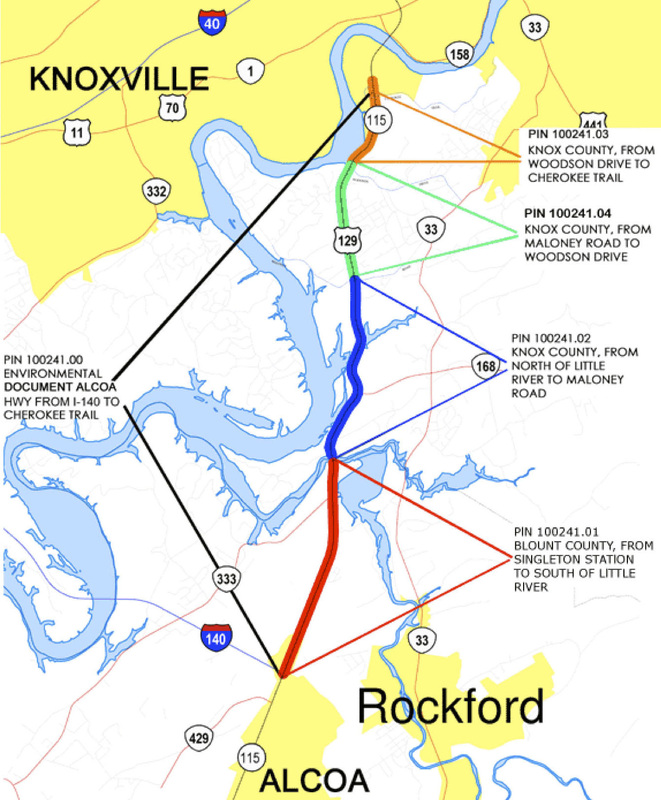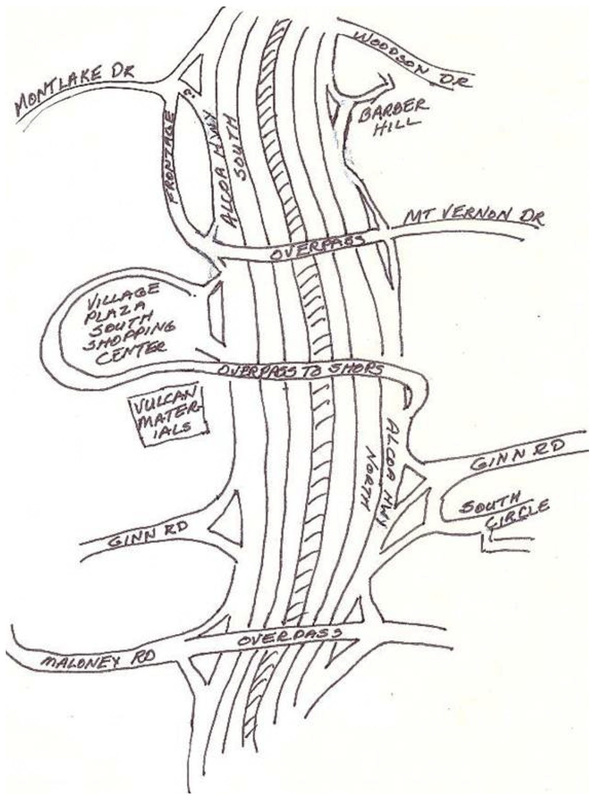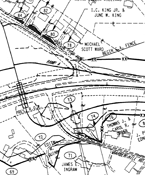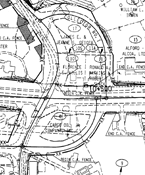Appendix B: Summary of the Alcoa Highway Redevelopment Project
By Marcia Finfer, October 2009
The Timberlake community, along with numerous other concerned citizen groups (including the Lakemoor Hills community) has actively participated in the formation of plans for the reconstruction of Alcoa Highway. This brief summary of the redevelopment plans attempts to explain the Tennessee Department of Transportation’s (TDOT’s) construction plan and presents limited information relating to the implementation schedule. It was obtained from numerous published reports, including Knoxville News Sentinel articles and TDOT’s Public Hearing Summary and webpage. It does not present the enormous number of letters to and from the community groups who contributed to discussions regarding safety issues and construction plans.
Background:
State Route 115 (US 129 Alcoa Highway) is a principal urban highway artery in the National Highway System, and is responsible for moving traffic between the cities of Alcoa and Knoxville. Figure A-1, TDOT Alcoa Highway Project Plan, depicts four projects planned for the improvement of the Alcoa corridor. An environmental impact study prepared for Alcoa Highway improvements addresses all four projects; the planned design approach for the entire highway section is consistent and will widen the existing highway to three lanes in each direction, with 12-foot wide shoulders and limited access control. This access will be limited to right-in/right-out only access, facilitated by new or reconstructed interchanges. The implementation schedule of the four projects will not be concurrent.
TDOT prepared a feasibility study for improvements to Alcoa Highway between State Route 35 and the Cherokee Trail Interchange in 1989. The City of Alcoa, the Knoxville/Knox County Metropolitan Planning Organization (MPO), and the Knoxville Airport authority retained consultants to review the feasibility study and make recommendations regarding the highway improvements relative to each organization’s domain. The resulting functional design plan of 1993 incorporates these organizations’ recommendations and includes:
The Timberlake community, along with numerous other concerned citizen groups (including the Lakemoor Hills community) has actively participated in the formation of plans for the reconstruction of Alcoa Highway. This brief summary of the redevelopment plans attempts to explain the Tennessee Department of Transportation’s (TDOT’s) construction plan and presents limited information relating to the implementation schedule. It was obtained from numerous published reports, including Knoxville News Sentinel articles and TDOT’s Public Hearing Summary and webpage. It does not present the enormous number of letters to and from the community groups who contributed to discussions regarding safety issues and construction plans.
Background:
State Route 115 (US 129 Alcoa Highway) is a principal urban highway artery in the National Highway System, and is responsible for moving traffic between the cities of Alcoa and Knoxville. Figure A-1, TDOT Alcoa Highway Project Plan, depicts four projects planned for the improvement of the Alcoa corridor. An environmental impact study prepared for Alcoa Highway improvements addresses all four projects; the planned design approach for the entire highway section is consistent and will widen the existing highway to three lanes in each direction, with 12-foot wide shoulders and limited access control. This access will be limited to right-in/right-out only access, facilitated by new or reconstructed interchanges. The implementation schedule of the four projects will not be concurrent.
TDOT prepared a feasibility study for improvements to Alcoa Highway between State Route 35 and the Cherokee Trail Interchange in 1989. The City of Alcoa, the Knoxville/Knox County Metropolitan Planning Organization (MPO), and the Knoxville Airport authority retained consultants to review the feasibility study and make recommendations regarding the highway improvements relative to each organization’s domain. The resulting functional design plan of 1993 incorporates these organizations’ recommendations and includes:
- No left turns and no median cuts
- No signals (for 20-year study period)
- One-way frontage roads (where warranted)
- Three lanes of through traffic in each direction
- Liberal use of right-in/right-out turns
- Moderate use of interchanges and crossovers
- Knox County – four new grade separations (bridges)
- Blount county – six new grade separations
The discussion that follows describes the project from Maloney Road to Woodson Drive (PIN 100241.04 in Figure B-1.).
Purpose:
To provide a partial access control facility to improve safety and efficiency for traffic movement from just south of Maloney Drive to north of Montlake Road with minimum interference. The proposed improvements are designed to eliminate left turns on and off Alcoa Highway. In addition, no median openings will be constructed, and for this project three bridges over Alcoa are proposed. The design speed is 50 mph.
The proposed improvements to the corridor will include three 12-feet traffic lanes in each direction, a twelve-foot outside shoulder for each traffic direction, and a median with a concrete barrier, thereby requiring a 138-feet proposed right of way.
Proposed Development Approach:
Figure B-2 is the author’s interpretation of the Maloney to Montlake portion of the Alcoa Project. It was obtained primarily from TDOT’s publication resulting from the Public Hearing, dated March 29, 1999. It is obviously subject to change, if it hasn’t been changed already.
This project is initiated south of Maloney Road, where a third northbound lane will be added, with tapering of the southbound side from three lanes to the existing two-lane section (in the event that this project is initiated prior to PIN100241.02-Figure B-1). A bridge over Alcoa is proposed for Maloney to eliminate left turns to and from the highway. New connector lanes to the bridge will be placed on both sides of Alcoa north of the overpass. These two-way connector roads tie Alcoa to Maloney and allow right-in/right-out movement from Alcoa. It allows motorists to proceed in either direction on Maloney and Alcoa; with the absence of left turns from Alcoa. Access control fences around the connector roads will prevent the connection of driveways and side roads.
Ginn Road, which is just north of Maloney on both east and west sides of Alcoa, will tie in as T-type intersections with a right-in/right-out only traffic pattern. South Circle Road will be closed at Alcoa Highway and a connection will be made to tie into Ginn Road on the east side.
A second bridge crossing over Alcoa is proposed at approximately 2300-feet north of Maloney to provide access to the shops in the Village Plaza South Shopping C enter and to improve traffic flow. This additional roadway will intersect the northbound lanes 656-feet north of Ginn and crosses over Alcoa at the Vulcan Materials entrance and continues west before circling behind the shopping center. It then intersects the southbound lanes at the shopping center entrance. This roadway will not be access controlled and will allow full access to businesses and the use of driveway connections.
A third bridge is proposed to support Mt Vernon Drive traffic. This overpass will have one lane of traffic in each direction. Mt. Vernon will be connected to Montlake Drive by a connector road on the west side of Alcoa; it will be a two-way, two lane access road, and will intersect Montlake 460-feet west of the intersection of Montlake and Alcoa. An exit ramp on this connector will allow traffic travelling westbound on Mt. Vernon to enter southbound Alcoa.
A connector road is proposed to the south and east of this interchange to allow right hand turns from northbound Alcoa onto Mt. Vernon and/or Montlake. This connector road will be an extension of the Bunker Hill Drive. Vehicles traveling northbound on Alcoa can use this connector road to access both Mt Vernon and Montlake. And in turn, vehicles using either Montlake or Mt. Vernon can use these connector roads to access northbound Alcoa by using the connector road.
The Montlake and the Barber Hill Lane intersections will also have the restriction of right-in/right-out turns with Alcoa. With left turn restrictions and concrete median barriers, all traffic from Montlake will be required to use the proposed Mt. Vernon overpass and connector roads. Traffic desiring to turn left from Barber Hill will be required to turn right and proceed to a section of Alcoa where a u-turn intersection is permissible. (The details of Woodson Drive to Cherokee Trail (PIN 100241.03, Figure B-1) address this interchange and are not available to the author at this time.)
Implementation Schedule:
The four Alcoa Highway projects are currently in the environmental Stage. The Environmental Document has been sent to the Federal Highway Administration Division for review. Several public meetings have been held; Planning Division meeting in 1997, Design Division Meeting in 1999, and three neighborhood meetings on interchanges at Woodson Drive, Montlake Drive and Mount Vernon Drive.
To date the Environmental Assessment findings indicate no significant impact. An evaluation of IC King Park has been defined. Public hearings and review will be held following approval of environmental documents, and the earliest date for a public hearing is spring 2010.
Required changes that result from the public hearings will be incorporated into the final Right of Way Plans, but no timetable beyond the spring 2010 public hearings has been established.
Right-of-way activity is underway for the section north of Maloney to Woodson, but no set timetables have been established for the remaining Alcoa Highway sections. (Because the right-of way acquisitions have been initiated in this section of the planned Alcoa corridor improvements, it would appear to the author that this project will be initiated first.)
The schedule of contract letting and beginning of construction has not yet been determined.
Other Notes and Observations:
TDOT provides advance notification of impending right-of-way acquisition once a project is approved. The Right of Way Office appraises purchases and, if required, assists families and businesses in relocating. To date, some of the properties have been bought along the planned Alcoa upgrade, including two residences on the west side of Alcoa between Montlake and the shopping center. The third residence belongs to Dick and Carol Warren, who also own property on Timberlake; as of this writing, they have not sold to TDOT and have rejected TDOT’s current offer. Another property, the first residence on the northwest side of Maloney, has also been acquired by TDOT, as has the business property of storage structures at the northwest corner of Alcoa and Maloney.
The Timberlake community held several meetings and produced a slew of letters encouraging changes to the Alcoa corridor to improve safety. These letters range in topics from asking for more police support for enforcing speed limits, to installation of stop lights, and to petitions for additional safety measures. Several community groups have been formed in the past, (e.g., Make Alcoa a Safe Highway (MASH)) to address the problems on Alcoa; the Mash report summarized findings in the summer of 1986. The MASH report is posted online at http://ttcknox.home.comcast.net/mash.pdf and is included in Appendix E of the Timberlake History Project (electronic version only). Several of our current Timberlake citizens participated in these earlier studies and public hearings, including John Rennie, Gene Burr, and Kermit Duckett. They are to be congratulated for their time, energy and inputs to make the (eventual) Alcoa Highway safer.
Ginn Road, which is just north of Maloney on both east and west sides of Alcoa, will tie in as T-type intersections with a right-in/right-out only traffic pattern. South Circle Road will be closed at Alcoa Highway and a connection will be made to tie into Ginn Road on the east side.
A second bridge crossing over Alcoa is proposed at approximately 2300-feet north of Maloney to provide access to the shops in the Village Plaza South Shopping C enter and to improve traffic flow. This additional roadway will intersect the northbound lanes 656-feet north of Ginn and crosses over Alcoa at the Vulcan Materials entrance and continues west before circling behind the shopping center. It then intersects the southbound lanes at the shopping center entrance. This roadway will not be access controlled and will allow full access to businesses and the use of driveway connections.
A third bridge is proposed to support Mt Vernon Drive traffic. This overpass will have one lane of traffic in each direction. Mt. Vernon will be connected to Montlake Drive by a connector road on the west side of Alcoa; it will be a two-way, two lane access road, and will intersect Montlake 460-feet west of the intersection of Montlake and Alcoa. An exit ramp on this connector will allow traffic travelling westbound on Mt. Vernon to enter southbound Alcoa.
A connector road is proposed to the south and east of this interchange to allow right hand turns from northbound Alcoa onto Mt. Vernon and/or Montlake. This connector road will be an extension of the Bunker Hill Drive. Vehicles traveling northbound on Alcoa can use this connector road to access both Mt Vernon and Montlake. And in turn, vehicles using either Montlake or Mt. Vernon can use these connector roads to access northbound Alcoa by using the connector road.
The Montlake and the Barber Hill Lane intersections will also have the restriction of right-in/right-out turns with Alcoa. With left turn restrictions and concrete median barriers, all traffic from Montlake will be required to use the proposed Mt. Vernon overpass and connector roads. Traffic desiring to turn left from Barber Hill will be required to turn right and proceed to a section of Alcoa where a u-turn intersection is permissible. (The details of Woodson Drive to Cherokee Trail (PIN 100241.03, Figure B-1) address this interchange and are not available to the author at this time.)
Implementation Schedule:
The four Alcoa Highway projects are currently in the environmental Stage. The Environmental Document has been sent to the Federal Highway Administration Division for review. Several public meetings have been held; Planning Division meeting in 1997, Design Division Meeting in 1999, and three neighborhood meetings on interchanges at Woodson Drive, Montlake Drive and Mount Vernon Drive.
To date the Environmental Assessment findings indicate no significant impact. An evaluation of IC King Park has been defined. Public hearings and review will be held following approval of environmental documents, and the earliest date for a public hearing is spring 2010.
Required changes that result from the public hearings will be incorporated into the final Right of Way Plans, but no timetable beyond the spring 2010 public hearings has been established.
Right-of-way activity is underway for the section north of Maloney to Woodson, but no set timetables have been established for the remaining Alcoa Highway sections. (Because the right-of way acquisitions have been initiated in this section of the planned Alcoa corridor improvements, it would appear to the author that this project will be initiated first.)
The schedule of contract letting and beginning of construction has not yet been determined.
Other Notes and Observations:
TDOT provides advance notification of impending right-of-way acquisition once a project is approved. The Right of Way Office appraises purchases and, if required, assists families and businesses in relocating. To date, some of the properties have been bought along the planned Alcoa upgrade, including two residences on the west side of Alcoa between Montlake and the shopping center. The third residence belongs to Dick and Carol Warren, who also own property on Timberlake; as of this writing, they have not sold to TDOT and have rejected TDOT’s current offer. Another property, the first residence on the northwest side of Maloney, has also been acquired by TDOT, as has the business property of storage structures at the northwest corner of Alcoa and Maloney.
The Timberlake community held several meetings and produced a slew of letters encouraging changes to the Alcoa corridor to improve safety. These letters range in topics from asking for more police support for enforcing speed limits, to installation of stop lights, and to petitions for additional safety measures. Several community groups have been formed in the past, (e.g., Make Alcoa a Safe Highway (MASH)) to address the problems on Alcoa; the Mash report summarized findings in the summer of 1986. The MASH report is posted online at http://ttcknox.home.comcast.net/mash.pdf and is included in Appendix E of the Timberlake History Project (electronic version only). Several of our current Timberlake citizens participated in these earlier studies and public hearings, including John Rennie, Gene Burr, and Kermit Duckett. They are to be congratulated for their time, energy and inputs to make the (eventual) Alcoa Highway safer.
Additional information
Click on image to download or view a larger graphic of the TDOT Montlake to Woodson Section and Alcoa Commercial Section. TDOT Plans provided by Lonnie Brown.
TDOT Website pertaining to Alcoa Highway: SR-115 (US-129) - Knox & Blount Counties
Click on image to download or view a larger graphic of the TDOT Montlake to Woodson Section and Alcoa Commercial Section. TDOT Plans provided by Lonnie Brown.
TDOT Website pertaining to Alcoa Highway: SR-115 (US-129) - Knox & Blount Counties






